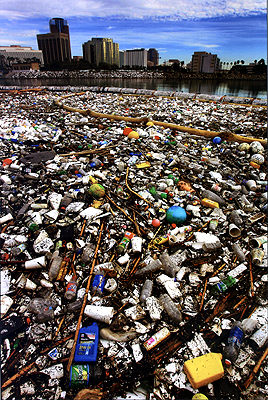 Did you know that there is a giant garbage patch in the Pacific Ocean? It is twice the size of Texas and it is currently floating somewhere between Hawaii and San Francisco. This floating island of garbage is 80% plastic and weighs 3.5 million tons.
Did you know that there is a giant garbage patch in the Pacific Ocean? It is twice the size of Texas and it is currently floating somewhere between Hawaii and San Francisco. This floating island of garbage is 80% plastic and weighs 3.5 million tons.
Continuing along with the attitude that we can all just throw away our used items (where is this ‘away’ anyway?), that what we do does not impact the earth and other inhabitants and that there is no consequence to our actions is not an attitude that will be tolerated or sustained for very much longer if we want to continue to live in a healthy environment. The biggest most powerful changes lie in the habits and attitudes of ordinary people. The Johns Hopkins community is now taking steps to stop the cycle of using up resources and throwing them ‘away.’
The GREEN Team
The mission of the Johns Hopkins Hospital Green Team is to create an environmentally- conscious culture that engages, and inspires social responsibility in employees, clients, and the wider community. This group was established in January of 2008, to reduce, recycle and reuse to lessen our impact on the environment. The Johns Hopkins Medical Laboratories joined in the Institutions Green Team initiatives in August 2008.
While it may feel like putting your soda can into a blue bin when you are finished with it is a very small step, it is important that we all remember that every small action has an impact. You have the power to change your attitudes. Small steps make a big difference.

Consider these amazing facts next time you feel too lazy to recycle:
Paper:
- Recycling 1 ton of paper saves 17 mature trees, 7,000 gallons of water, 3 cubic yards of landfill space, 2 barrels of oil, and 4,100 kilowatt-hours of electricity — enough energy to power the average American home for five months. (EPA, 2008)
- Recycling paper instead of making it from new material generates 74 percent less air pollution and uses 50 percent less water. (EPA, 2008)
- Metal:
- Recycling one aluminum can saves enough energy to run a 100-watt bulb for 20 hours, a computer for 3 hours, or a TV for 2 hours. (EPA, 2008)
- Recycling aluminum saves 95% of the energy used to make the material from scratch. That means you can make 20 cans out of recycled material with the same amount of energy it takes to make one can out of new material. Energy savings in 1993 alone were enough to light a city the size of Pittsburgh for six years.
Plastic:
- If every American household recycled just one out of every ten HDPE bottles they used, we’d keep 200 million pounds of the plastic out of landfills every year.
GREEN Initiatives at Hopkins
The initiatives that have been undertaken at Johns Hopkins to meet these greener objectives have taken place in a number of ways.
- One initiative involves a hospital wide recycling program. Large blue bins have been distributed in the hallways on campus. A wide range of recyclable items (paper, cardboard, plastic and glass and aluminum beverage containers) can be put into these for collection by the Department of Environmental Services. Smaller desk-side bins for collecting your personal paper waste, beverage bottles and cans can be obtained as well. These can also be found in break rooms and common areas, but individuals are responsible for emptying the contents when full into the larger blue bins.
- If you don’t have the large blue recycle bin in your area yet, you can contact Ms. Mercedes Henderson – manager for the Department of Environmental Services (mhenders@jhmi) to find out more information)
- Another initiative involved the change to the use of recycled paper for printing and copying. Paper makes up almost a third of the material that goes into landfills. For every ton of paper recovered by recycling, about 3 cubic yards of landfill space are saved.
- The initiative involving the laboratories includes the use of Biosystems for sharps disposal. The Biosystem Sharps Management program uses reusable sharps containers, thereby eliminating most disposable plastic sharps containers.
Other ways laboratories and office spaces can contribute to ensure energy is conserved:
- Unplug laptop power cords when not in use and turn off equipment and lights at the end of the day
- Print materials for handouts double-sided
- The use of rechargeable batteries will help decrease the amount of landfill waste
- Work with manufacturers and vendors to decrease the plastic and paper packing materials for reagents
- All non-critical electrical equipment can be switched off when it is not needed.
- Close hood sashes and disable unused hoods
- Cut off computer monitors when not in use, weekends and nights.
- Defrost your freezers regularly. The frost insulates the coils and makes the compressor work harder to pull heat away.
So, Go Green and encourage your coworkers to recycle!
Ellen Winslow, Pathology Administration &
Natalie Wallace, Continuous Quality Improvement Office